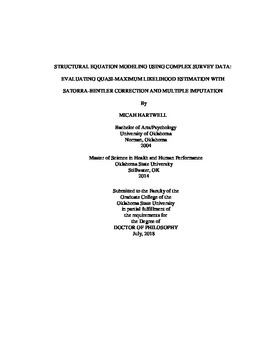| dc.contributor.advisor | Khojasteh, Jam | |
| dc.contributor.author | Hartwell, Micah | |
| dc.date.accessioned | 2019-03-20T19:25:34Z | |
| dc.date.available | 2019-03-20T19:25:34Z | |
| dc.date.issued | 2018-07 | |
| dc.identifier.uri | https://hdl.handle.net/11244/317633 | |
| dc.description.abstract | As a theory-guided approach, SEM can estimate directional pathways in complex models using longitudinal or cross-sectional data where randomized control trials would either be unethical or cost prohibitive, thereby providing researchers with an alternative approach for delineating causal relationships. As SEM is a technique requiring large sample size, federal and state level surveys are often used, which are designed with complex sampling strategies. As many of the variables and in turn, weighted-ness, may be subject to non-normality, it is important to adjust the SEM model fit statistics to more closely match the reference distribution (Satorra-Bentler, 1994). Further, missing data is a regular issue in nearly all surveys, especially those with large-scale, complex designs. The purpose of the study is to provide a comparison of estimations, modification indices, and goodness-of-fit tests for SEM between standard maximum likelihood estimation and quasi-maximum likelihood using Satorra-Bentler correction using a complex survey data and multiple imputation. Using non-simulated data with missingness can provide guidance on how to incorporate both SEM and multiple imputation in future research. This study found that coefficients were the same regardless of estimator; however, standard errors increased under QML. Model fit statistics were better under QML, and Lagrange multiplier values from the modification indices were on average lower under QML, however, only with structural model components. | |
| dc.format | application/pdf | |
| dc.language | en_US | |
| dc.rights | Copyright is held by the author who has granted the Oklahoma State University Library the non-exclusive right to share this material in its institutional repository. Contact Digital Library Services at lib-dls@okstate.edu or 405-744-9161 for the permission policy on the use, reproduction or distribution of this material. | |
| dc.title | Structural equation modeling using complex survey data: Evaluating quasi-maximum likelihood estimation with Satorra-Bentler correction and multiple imputation | |
| dc.contributor.committeeMember | Barnes, Laura | |
| dc.contributor.committeeMember | Wheeler, Denna | |
| dc.contributor.committeeMember | Croff, Julie | |
| osu.filename | Hartwell_okstate_0664D_15806.pdf | |
| osu.accesstype | Open Access | |
| dc.type.genre | Dissertation | |
| dc.type.material | text | |
| dc.subject.keywords | complex survey design | |
| dc.subject.keywords | missingness | |
| dc.subject.keywords | multiple imputation | |
| dc.subject.keywords | nhanes | |
| dc.subject.keywords | quasi-maximum likelihood | |
| dc.subject.keywords | structural equation modeling | |
| thesis.degree.discipline | Educational Psychology | |
| thesis.degree.grantor | Oklahoma State University | |
